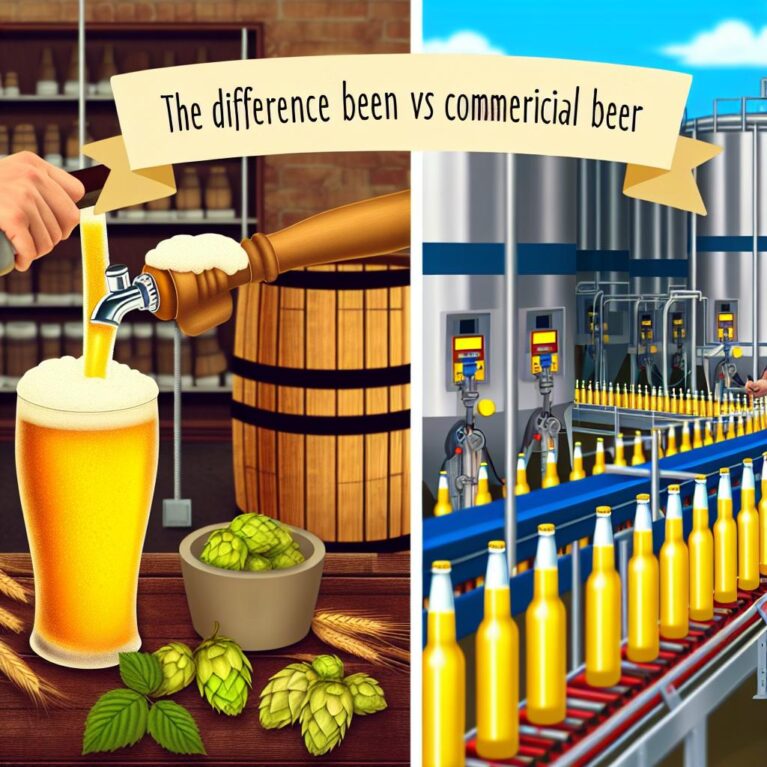Understanding Beer Types: Craft vs. Commercial
When discussing beer, two main categories often arise: craft beer and commercial beer. The distinction between these two types is not solely about taste or preference but also involves production methods, marketing approaches, and the philosophy behind brewing.
What Defines Craft Beer?
Craft beer is typically produced by small, independent breweries. According to the Brewers Association, a craft brewer is small, producing 6 million barrels of beer or less annually. The independence aspect means that less than 25% of the brewery is owned or controlled by a beverage alcohol industry member who is not a craft brewer.
Distinctive flavors and innovative brewing techniques are hallmarks of craft beer. Brewers experiment with a variety of ingredients, such as unique hops and malt profiles, and may introduce unconventional methods to create new and exciting beer styles. This experimentation allows for a wide range of tastes and aromas, often resulting in unique combinations that reflect the brewer’s tastes and creativity. Craft brewers often take pride in developing signature styles that may not conform to traditional brewing norms.
Commercial Beer Production
Commercial beer, on the other hand, is produced by large-scale breweries. These breweries operate on a significantly larger scale than their craft counterparts and often focus on mass production. The primary goal is to produce beer with consistent taste, quality, and appearance, typically achieved through streamlined processes and rigorous quality control measures.
Major brands like Budweiser, Heineken, and Coors fall into this category. Their beers are designed to appeal to a broad audience, which often results in milder flavor profiles compared to the often bolder craft beers. Consistency is a key factor here; consumers expect every can or bottle to taste the same, no matter where they are purchased or consumed. To achieve this, commercial brewers utilize advanced techniques and technologies that align with industrial production standards.
Brewing Methods and Ingredients
Craft breweries often prioritize quality over quantity, resulting in limited batches with seasonal or specialty offerings. They tend to use both traditional and innovative brewing methods and frequently source local and sustainable ingredients. This approach allows craft brewers to devise niche products that cater to specific tastes, often pushing the boundaries of what is conventionally expected from beer.
On the contrary, commercial breweries utilize efficient production technologies to maximize output while maintaining consistency across large volumes. This can involve using adjuncts like rice or corn to cut costs while ensuring the beer remains approachable for the mass market. Such adjuncts tend to lighten the body and flavor of the beer, making it milder and more consistent. Commercial brewers often employ large fermentation tanks and automated systems to speed up production and maintain uniformity.
Marketing and Community Involvement
An important aspect differentiating craft and commercial beer lies in their marketing strategies and community engagement practices. Craft breweries are known for building strong community ties and frequently engage in local events, collaborations, and partnerships. Their marketing often focuses on the unique story behind each beer and the people who brew it. This personal touch allows craft breweries to form tangible connections with their consumers, fostering a sense of community and loyalty. Additionally, they may hold events, tastings, and tours to further engage with their audience.
On the other hand, commercial breweries, due to their size and resources, invest significantly in large-scale marketing campaigns to reach a global audience. They often sponsor major events and utilize mass media advertising to reinforce brand recognition. This expansive reach allows these brands to maintain their presence in multitudes of markets, but it also limits their personalization. The marketing aims to appeal to as wide an audience as possible, often conveying a message of consistency and reliability.
The Brewing Philosophy: Craft vs. Commercial
Beyond the tangible differences, there is a philosophical divergence between craft and commercial brewing. Craft brewing tends to focus on artisanal quality and creativity, embodying a philosophy that favors small-scale production and localism. Craft brewers often view themselves as artisans or craftspeople, passionately focused on the history and culture of beer. They tend to innovate with new techniques or resurrect ancient brewing traditions, all to produce a distinctive final product that reflects their personal touch.
Conversely, commercial brewing prioritizes economies of scale and efficiency. It emphasizes the logistics and technologies required to deliver a consistent product in vast quantities to a global market. Commercial brewers may experiment with new products, but these are thoroughly researched and tested to ensure they appeal to the broadest possible demographic. Their approach often involves a balance between cost-effectiveness and maintaining a safe, reliable product that can satisfy millions of customers worldwide.
Conclusion
The differences between craft beer and commercial beer extend beyond the brewing process to include cultural and economic dimensions. While craft beer emphasizes creativity, quality, and local engagement, commercial beer focuses on consistency, large-scale distribution, and broad market appeal. Whether you prefer craft or commercial beer largely depends on your taste preferences and values. Understanding these distinctions can enhance your appreciation for the diverse landscape of beer options available today. Both categories have distinct advantages and cater to different parts of the beer-drinking community, reflecting varied consumer expectations and experiences in the world of beer.

